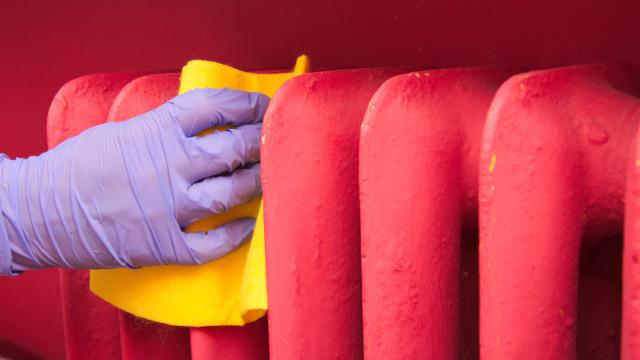Cast iron radiators have been around since the 1860s, using steam to heat the accordion-shaped coils and keep rooms warm during the winter. A central boiler heats water, creating steam that rises through the pipes and into the radiators, and the tightly folded coils retain heat for longer, staying hot even once the boiler is turned off. But these radiators lose their efficiency when dust and grime build up on the coils, preventing the heat from pushing through. Here are some steps to properly clean your cast iron radiator.
Prep the space and get your tools
The best way to keep the radiators clean is to wipe them down weekly with water and a cloth, but cleaning all the radiators in your home is likely a weekly chore that no one will remember. For longer periods between cleaning, a deeper clean is necessary. You’ll need:
- A vacuum
- A bucket
- Water
- Cleaning solution
- A radiator cleaning brush or long thick stick
- Two cloths — one for washing and one for drying
- A drop cloth or plastic to cover the floors
Turn the radiator off
Your radiator should have a nob that stops the steam from coming through. Some look like a cap with arrows for which directions are on and off, while others might look like a thermostat. Be sure your radiator is off and cool before starting to clean.
Vacuum the radiator
Using a vacuum attachment, get behind, under, and in between the coils of your radiator. When you’re done, place a drop cloth under your radiator for the next step. If you want to protect your walls as well, use painter’s tape to add plastic to the wall behind the radiator.
Choose the right cleaning brush
A radiator cleaning brush looks like a lint brush or an old school chimney sweep tool. If you don’t have one — and you likely don’t — it’s not hard to make your own by taking a long stick and wrapping a cleaning cloth around it, securing it with some strong tape.
Clean your radiator
Get your bucket and fill it with warm water, which is more efficient at lifting dirt than cold. Then add a little bit of cleaning solution to the water — any dishwashing liquid will do — and dampen your cloth or radiator brush. Clean between the radiator coils, and watch how much dirt comes onto your brush and falls on the plastic drop cloth below. Once the radiator’s clean, it’s important to dry it with an additional dry cloth to prevent rusting.
Consider internal cleaning if it’s still not running effectively
If your radiator still isn’t heating your space as well as expected, it may need an internal flush, as internal cleaning is required when sludge builds up inside the coils. “Central heating systems can be cleaned with sludge removal chemicals or a power flush,” says the Radiator Centre. But this one should only be done by a licensed plumber, so ask your landlord or call a professional.

Leave a Reply
You must be logged in to post a comment.